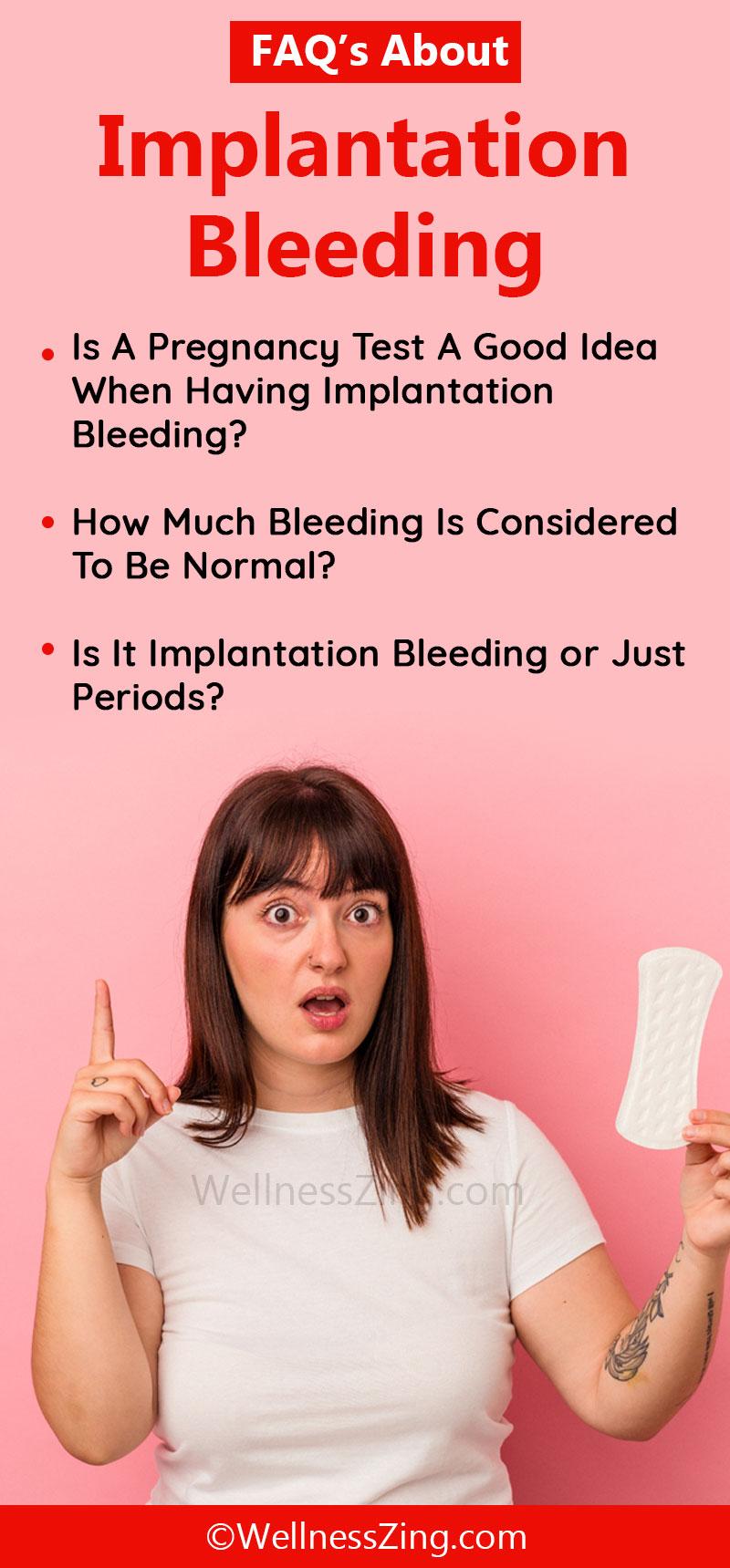Frequently Asked Questions Regarding Implantation Bleeding
1. How does implantation bleeding seem to be like?
If you find out light blood traces in brown or pinkish color on toilet paper, it is termed as implantation bleeding. The bleeding usually lasts for 1 to 3 days without any clots.
2. Is a pregnancy test a good idea when having implantation bleeding?
Yes, even while having implantation bleeding, going for a pregnancy test at home can be helpful as it actually helps with precise results. The test should be carried out after the first day of missing the period.
3. How much bleeding is considered to be normal during implantation bleeding?
Implantation bleeding is quite little or light. When noticed, only some blood spots would appear in brown or pinkish color. The spots shouldn’t contain any tissue clots.
4. When does implantation bleeding generally start?
When the fertilized egg gets attached to the uterus, at that time many women have implantation bleeding. This can be approximately 10 – 14 days after conceiving. For those having a regular period cycle, bleeding is possible it can occur on the date you are expecting your period.
5. Is implantation bleeding observed in every pregnancy or only the first one?
Women may or may not have implantation bleeding in every pregnancy. It can be observed in one pregnancy and be absent in the next pregnancy.
Is it implantation bleeding? Or just periods?
Spotting or light bleeding is surely not connected with pregnancy; however, some women may suffer from implantation bleeding during the early pregnancy phase once they have conceived.
If you are in the waiting period for a pregnancy test, you might also look for some initial pregnancy signs too. And implantation bleeding can be one of the early signs. Implantation bleeding is usually observed when the fertilized egg gets nestled in the lining of the uterus. And menstruation or periods is the monthly bleeding women experience at the reproductive age, which usually stops when any woman conceives. Hence, when women observe some minor spotting on the underwear, they are sure to get confused with whether it is the starting of their menses or have they successfully entered the path to pregnancy.
Through this piece of information, let’s learn about implantation bleeding and how it differs from periods.
What is Implantation Bleeding?
Many times, women ovulate when they are halfway of their menstruation cycle. In this case, if you miss your periods even after 2 weeks of ovulation, you are surely pregnant. If the sperm gets fertilized successfully with the egg released at the time of ovulation, you surely have conceived. The new embryo would then travel from the uterus by connecting with the lining if everything is normal. When this process takes place, the embryo may whisk with the blood cells in the lining leading to the release of blood in the form of bleeding from the body. This release of blood in the form of bleeding is termed as implantation bleeding which is among the primary signs of pregnancy.
Is Implantation Bleeding common?
There are high chances that one out of four women suffer from implantation bleeding while conceiving as an initial sign. As per a research carried out by the National Institute of Child Health and Human Development, 25% of pregnant women have light spotting after around 6 to 12 days of conception. The color of such spotting is light compared to the bleeding during menstruation.
As per the experts, early bleeding is quite common and danger-free. Around 9% of the women with clinical pregnancy are likely to have implantation bleeding in the first 8 weeks of their pregnancy. And nearly 85% of such pregnancies end up with live birth. Hence, through these details, it can be determined that having implantation bleeding or bleeding in the initial pregnancy phase can result in a successful pregnancy.
Thinking what is the right time of expecting implantation bleeding? Women generally observe implantation bleeding when their periods are due, or on the day of implantation. At times, implantation bleeding can also delay as the blood has to make its way out of the body which takes time.
Implantation bleeding is surely a normal sign of early pregnancy, with no risk on the developing baby. But if some other symptoms are also observed along with the bleeding, such as pain in the lower abdomen, vomiting, dizziness, nausea, etc. you surely need to visit your doctor as it can be due to ectopic pregnancy.
What are the signs of implantation bleeding?
No doubt, it is quite difficult to learn the difference between an early period or implantation bleeding, there are some signs that would help you know what actually is happening to your body.
1. Flow strength
Implantation bleeding is basically quite a light spot. Such spotting usually remains for a day or minor bleeding. However, on the other hand, the flow during the periods may start with a light spot, but the flow would get stronger as time passes.
2. Color of bleeding
Bleeding during implantation bleeding is pinkish-brown in color. While during menses, the bleeding might be in light brown or pink color, but it soon would turn out to be crimson red or darker.
3. Clotting
Clotting is another way to determine whether it is implantation bleeding or periods. When you find blood clots in the bleeding, it is surely due to your periods. Implantation bleeding wouldn’t be a mixture of tissues and blood.
4. Cramping
Cramping at the time of implantation bleeding is generally transitory and light. While during menses, cramping is generally long-lasting and intense. But every woman comes with different pain brink, so learn about the body to learn better from it.
5. Consistency
Consistency during implantation bleeding is generally on and off type. While during periods, it may start lightly but as it progresses, it gets heavier.
6. Flow length
Implantation bleeding can last for nearly 1 to 3 days, while periods would last for nearly 5 to 7 days in which the third and fourth day would be with heavy flows.
Hence, these are some of the basic signs you can keep a watch over for determining whether you are having your periods or merely implantation bleeding. While suffering from implantation bleeding, women are likely to suffer light stomach cramps, headaches, and even mood swings which can make it tricky to determine what is going on inside them. Lastly, keeping a watch on the breasts can also help in learning about implantation bleeding. On the 18th day of your cycle, if your breasts turn out to be tender, it can be possible due to implantation bleeding.
Period Vs. Implantation Bleeding – What is the difference?
Thinking what is the difference between periods and implantation bleeding? Well, keeping a watch on the bleeding can surely help in determining whether you have conceived or not. Here is how you can differentiate between periods and implantation bleeding.
1. Bleeding duration
Implantation bleeding occurs when the egg gets implanted in the uterus, and this process lasts for some weeks or for a day or two. Hence, women might have implantation bleeding for 1 to 3 days which is quite light with no clots. While talking about periods, during that time, the body releases the unfertilized egg from the body due to which bleeding occurs and lasts for nearly 4 to 7 days with heavy flow.
2. Bleeding color
When having implantation bleeding, the color of the spots or discharge would be either dark brown or with a pinkish shade. While the color of bleeding during periods would be a bright, or vibrant red.
3. Cramps
When the egg is getting attached to the uterus or womb, women are likely to suffer from mild cramping. The cramps during implantation bleeding are quite tolerable and mild. However, cramps during menstruation are generally intense and can get stronger as days pass.
4. Timing
Implantation bleeding is usually observed in around 10 days of ovulation. While menses generally occur after 14 days. Hence, having a pinkish spot in your undies on the 22nd to 25th day is likely to be implantation bleeding while the spotting in menstruation would start nearly on the 26th or 27th day.
Hence, by keeping a watch on the bleeding, it’s color, and timing, you can easily determine if it is normal bleeding or you have conceived successfully.
Along with this, some other pregnancy symptoms you can look for to confirm that it is implantation bleeding include:
- Nausea
- Mood swings
- Tender breasts
- Lower back pain
- Headaches
- Fatigue
Such early signs can be observed due to particular hormonal changes in the body when it supports a pregnancy.
When should you go for a pregnancy test?
Learning the difference between implantation bleeding and menstruation bleeding can be quite multifaceted. Hence, if are you looking for conceiving it is highly advised to go for a self-test or pregnancy test at home as soon as you miss out on your periods. Again, with implantation bleeding which is quite normal, women can also go through ordinary health issues like irritation of the cervix, infection in the vagina, etc.
Apart from implantation bleeding, other reasons for bleeding in early pregnancy include ectopic pregnancy, miscarriage, or molar pregnancy. Hence, one should avoid taking a chance on experiencing bleeding and seek some medical help as soon as such symptoms are observed.
Don’t worry, if the bleeding is light and short-termed, there are high chances of having some good news from the doctor.
What are other reasons for having bleeding during pregnancy?
Apart from implantation bleeding, there are other possibilities of having bleeding once you have missed the periods. No doubt, bleeding in the initial three months is widely termed to be common, it can still be due to other serious issues which surely needs to be considered serious and quick attention of the doctor.
Light bleeding can also be due to particular minor things. Like if the cervix is quite sensitive and is developing more blood vessels, going for a pelvic exam or sex can lead to bleeding. Apart from such bleeding issues, if heavy bleeding or bright red blood is observed, it can be due to some serious issues like:
1. Ectopic pregnancy
The chances of having an ectopic pregnancy are merely 1% or 2%. This situation takes place when the egg gets fertilized outside the placenta. Hence, along with bleeding, if you are having unbearable pain on either side or back, contact your doctor immediately.
2. Subchorionic hemorrhage
Subchorionic hemorrhage is observed when the placenta separates from the original implantation site. Also, blood clots are found developing on the uterus wall.
3. Molar pregnancy
Molar pregnancy is a state when a tissue mass or non-viable fertilized egg is found developing from the egg implanted, and not a baby. Molar pregnancy is also termed as a gestational trophoblastic health issue that grows into a tissue mass in the uterus which has swollen chorionic villi.
4. Miscarriage
Also termed as spontaneous abortion, miscarriage is defined as loss of pregnancy prior to 20 weeks. It is among the most common complications for pregnancy suffered by around 80% of women in the first trimester.
Hence, even if after having a positive test, if you are experiencing bleeding, be sure to contact your gynecologist to be sure nothing is serious in there.
Conclusion
Keeping a complete track of the changes in your body is surely complicated and a full-time job. The task becomes additionally excruciating when you are working out if you have conceived or not. So, to make it simple, use the calendar for tracking the dates. Mark the first and last day of your periods along with the approximate conception date. Noting the symptoms, you are suffering from on the timeline would also be helpful for determining when to take a pregnancy test.
If you are not sure about the bleeding or it seems to be an abnormal situation, contact your doctor for working out on the next steps. No doubt, the waiting game is quite tough, there is surely a substitute way leading to some good news






















